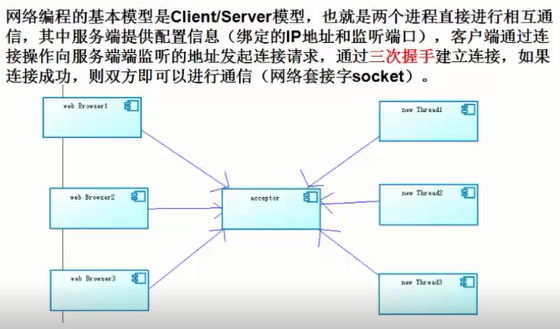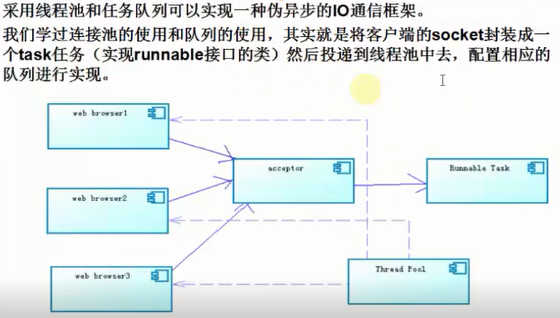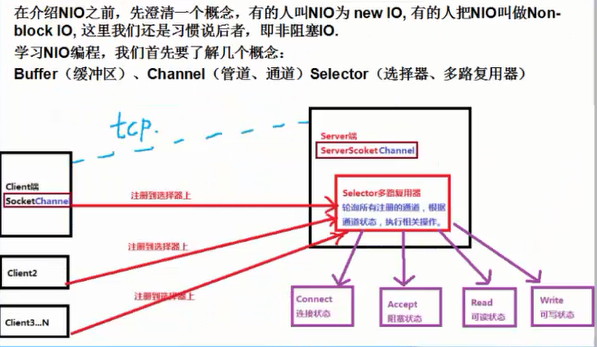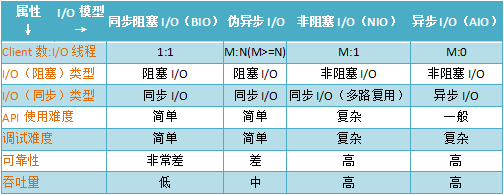Java 网络IO编程(BIO、NIO、AIO)
2018-06-18 03:08:36来源:未知 阅读 ()

本概念

BIO编程
传统的BIO编程

代码示例:

public class Server { final static int PROT = 8765; public static void main(String[] args) { ServerSocket server = null; try { server = new ServerSocket(PROT); System.out.println(" server start .. "); // 进行阻塞 Socket socket = server.accept(); // 新建一个线程执行客户端的任务 new Thread(new ServerHandler(socket)).start(); } catch (Exception e) { e.printStackTrace(); } finally { if (server != null) { try { server.close(); } catch (IOException e) { e.printStackTrace(); } } server = null; } } } public class ServerHandler implements Runnable { private Socket socket; public ServerHandler(Socket socket) { this.socket = socket; } @Override public void run() { BufferedReader in = null; PrintWriter out = null; try { in = new BufferedReader(new InputStreamReader(this.socket.getInputStream())); out = new PrintWriter(this.socket.getOutputStream(), true); String body = null; while (true) { body = in.readLine(); if (body == null) break; System.out.println("Server :" + body); out.println("服务器端回送响的应数据."); } } catch (Exception e) { e.printStackTrace(); } finally { if (in != null) { try { in.close(); } catch (IOException e) { e.printStackTrace(); } } if (out != null) { try { out.close(); } catch (Exception e) { e.printStackTrace(); } } if (socket != null) { try { socket.close(); } catch (IOException e) { e.printStackTrace(); } } socket = null; } } } public class Client { final static String ADDRESS = "127.0.0.1"; final static int PORT = 8765; public static void main(String[] args) { Socket socket = null; BufferedReader in = null; PrintWriter out = null; try { socket = new Socket(ADDRESS, PORT); in = new BufferedReader(new InputStreamReader(socket.getInputStream())); out = new PrintWriter(socket.getOutputStream(), true); // 向服务器端发送数据 out.println("接收到客户端的请求数据..."); // out.println("接收到客户端的请求数据1111..."); String response = in.readLine(); System.out.println("Client: " + response); } catch (Exception e) { e.printStackTrace(); } finally { if (in != null) { try { in.close(); } catch (IOException e) { e.printStackTrace(); } } if (out != null) { try { out.close(); } catch (Exception e) { e.printStackTrace(); } } if (socket != null) { try { socket.close(); } catch (IOException e) { e.printStackTrace(); } } socket = null; } } }
该模型最大的问题就是缺乏弹性伸缩能力,当客户端并发访问量增加后,服务端的线程个数和客户端并发访问数呈1:1的正比关系,Java中的线程也是比较宝贵的系统资源,线程数量快速膨胀后,系统的性能将急剧下降,随着访问量的继续增大,系统最终就死-掉-了。
伪异步I/O编程

代码示例:

public class Server { final static int PORT = 8765; public static void main(String[] args) { ServerSocket server = null; BufferedReader in = null; PrintWriter out = null; try { server = new ServerSocket(PORT); System.out.println("server start"); Socket socket = null; HandlerExecutorPool executorPool = new HandlerExecutorPool(50, 1000); while (true) { socket = server.accept(); executorPool.execute(new ServerHandler(socket)); } } catch (Exception e) { e.printStackTrace(); } finally { if (in != null) { try { in.close(); } catch (Exception e1) { e1.printStackTrace(); } } if (out != null) { try { out.close(); } catch (Exception e2) { e2.printStackTrace(); } } if (server != null) { try { server.close(); } catch (Exception e3) { e3.printStackTrace(); } } server = null; } } } public class ServerHandler implements Runnable { private Socket socket; public ServerHandler(Socket socket) { this.socket = socket; } @Override public void run() { BufferedReader in = null; PrintWriter out = null; try { in = new BufferedReader(new InputStreamReader(this.socket.getInputStream())); out = new PrintWriter(this.socket.getOutputStream(), true); String body = null; while (true) { body = in.readLine(); if (body == null) break; System.out.println("Server:" + body); out.println("Server response"); } } catch (Exception e) { e.printStackTrace(); } finally { if (in != null) { try { in.close(); } catch (Exception e1) { e1.printStackTrace(); } } if (out != null) { try { out.close(); } catch (Exception e2) { e2.printStackTrace(); } } if (socket != null) { try { socket.close(); } catch (Exception e3) { e3.printStackTrace(); } } socket = null; } } } public class HandlerExecutorPool { private ExecutorService executor; public HandlerExecutorPool(int maxPoolSize, int queueSize){ this.executor = new ThreadPoolExecutor( Runtime.getRuntime().availableProcessors(), maxPoolSize, 120L, TimeUnit.SECONDS, new ArrayBlockingQueue<Runnable>(queueSize)); } public void execute(Runnable task){ this.executor.execute(task); } } public class Client { final static String ADDRESS = "127.0.0.1"; final static int PORT = 8765; public static void main(String[] args) { Socket socket = null; BufferedReader in = null; PrintWriter out = null; try { socket = new Socket(ADDRESS, PORT); in = new BufferedReader(new InputStreamReader(socket.getInputStream())); out = new PrintWriter(socket.getOutputStream(), true); out.println("Client request"); String response = in.readLine(); System.out.println("Client:" + response); } catch (Exception e) { // TODO Auto-generated catch block e.printStackTrace(); } finally { if (in != null) { try { in.close(); } catch (Exception e1) { e1.printStackTrace(); } } if (out != null) { try { out.close(); } catch (Exception e2) { e2.printStackTrace(); } } if (socket != null) { try { socket.close(); } catch (Exception e3) { e3.printStackTrace(); } } socket = null; } } }
该模式使用线程池,我们就有效的控制了线程的最大数量,保证了系统有限的资源的控制,实现了N:M的伪异步I/O模型。但是,正因为限制了线程数量,如果发生大量并发请求,超过最大数量的线程就只能等待,直到线程池中的有空闲的线程可以被复用。而对Socket的输入流就行读取时,会一直阻塞,直到发生:
- 有数据可读
- 可用数据以及读取完毕
- 发生空指针或I/O异常
所以在读取数据较慢时(比如数据量大、网络传输慢等),大量并发的情况下,其他接入的消息,只能一直等待,这就是最大的弊端。
NIO 编程
简介

NIO提供了与传统BIO模型中的Socket和ServerSocket相对应的SocketChannel和ServerSocketChannel两种不同的套接字通道实现。
新增的着两种通道都支持阻塞和非阻塞两种模式。
阻塞模式使用就像传统中的支持一样,比较简单,但是性能和可靠性都不好;非阻塞模式正好与之相反。
对于低负载、低并发的应用程序,可以使用同步阻塞I/O来提升开发速率和更好的维护性;对于高负载、高并发的(网络)应用,应使用NIO的非阻塞模式来开发。
缓冲区 Buffer
Buffer是一个对象,包含一些要写入或者读出的数据。
在NIO库中,所有数据都是用缓冲区处理的。在读取数据时,它是直接读到缓冲区中的;在写入数据时,也是写入到缓冲区中。任何时候访问NIO中的数据,都是通过缓冲区进行操作。
缓冲区实际上是一个数组,并提供了对数据结构化访问以及维护读写位置等信息。
具体的缓存区有这些:ByteBuffe、CharBuffer、 ShortBuffer、IntBuffer、LongBuffer、FloatBuffer、DoubleBuffer。他们实现了相同的接口:Buffer。
具体介绍可参照 http://ifeve.com/buffers/
通道 Channel
我们对数据的读取和写入要通过Channel,它就像水管一样,是一个通道。通道不同于流的地方就是通道是双向的,可以用于读、写和同时读写操作。
底层的操作系统的通道一般都是全双工的,所以全双工的Channel比流能更好的映射底层操作系统的API。
Channel主要分两大类:
- SelectableChannel:用户网络读写
- FileChannel:用于文件操作
后面代码会涉及的ServerSocketChannel和SocketChannel都是SelectableChannel的子类。
多路复用器 Selector
Selector是Java NIO 编程的基础。
Selector提供选择已经就绪的任务的能力:Selector会不断轮询注册在其上的Channel,如果某个Channel上面发生读或者写事件,这个Channel就处于就绪状态,会被Selector轮询出来,然后通过SelectionKey可以获取就绪Channel的集合,进行后续的I/O操作。
一个Selector可以同时轮询多个Channel,因为JDK使用了epoll()代替传统的select实现,所以没有最大连接句柄1024/2048的限制。所以,只需要一个线程负责Selector的轮询,就可以接入成千上万的客户端。

代码示例:

public class Server implements Runnable { // 1 多路复用器(管理所有的通道) private Selector seletor; // 2 建立缓冲区 private ByteBuffer readBuf = ByteBuffer.allocate(1024); // 3 private ByteBuffer writeBuf = ByteBuffer.allocate(1024); public Server(int port) { try { // 1 打开路复用器 this.seletor = Selector.open(); // 2 打开服务器通道 ServerSocketChannel ssc = ServerSocketChannel.open(); // 3 设置服务器通道为非阻塞模式 ssc.configureBlocking(false); // 4 绑定地址 ssc.bind(new InetSocketAddress(port)); // 5 把服务器通道注册到多路复用器上,并且监听阻塞事件 ssc.register(this.seletor, SelectionKey.OP_ACCEPT); System.out.println("Server start, port :" + port); } catch (IOException e) { e.printStackTrace(); } } @Override public void run() { while (true) { try { // 1 必须要让多路复用器开始监听 // 阻塞,等待客户端操作(连接或者写入数据) // 客户端刚连上时,key为isAcceptable;客户端输入数据时,key为isReadable; this.seletor.select(); // 2 返回多路复用器已经选择的结果集 Iterator<SelectionKey> keys = this.seletor.selectedKeys().iterator(); // 3 进行遍历 while (keys.hasNext()) { // 4 获取一个选择的元素 SelectionKey key = keys.next(); // 5 直接从容器中移除就可以了 keys.remove(); // 6 如果是有效的 if (key.isValid()) { // 7 如果为阻塞状态 if (key.isAcceptable()) { this.accept(key); } // 8 如果为可读状态 if (key.isReadable()) { this.read(key); } // 9 写数据 if (key.isWritable()) { // this.write(key); //ssc } } } } catch (IOException e) { e.printStackTrace(); } } } // 向客户端写数据是通过ServerSocketChannel的来写 private void write(SelectionKey key) { // ServerSocketChannel ssc = (ServerSocketChannel) key.channel(); // ssc.register(this.seletor, SelectionKey.OP_WRITE); } private void read(SelectionKey key) { try { // 1 清空缓冲区旧的数据 this.readBuf.clear(); // 2 获取之前注册的socket通道对象 SocketChannel sc = (SocketChannel) key.channel(); // 3 读取数据 int count = sc.read(this.readBuf); // 4 如果没有数据 if (count == -1) { key.channel().close(); key.cancel(); return; } // 5 有数据则进行读取 读取之前需要进行复位方法(把position 和limit进行复位) this.readBuf.flip(); // 6 根据缓冲区的数据长度创建相应大小的byte数组,接收缓冲区的数据 byte[] bytes = new byte[this.readBuf.remaining()]; // 7 接收缓冲区数据 this.readBuf.get(bytes); // 8 打印结果 String body = new String(bytes).trim(); System.out.println("Server : " + body); // 9..可以写回给客户端数据 } catch (IOException e) { e.printStackTrace(); } } private void accept(SelectionKey key) { try { // 1 获取服务通道 ServerSocketChannel ssc = (ServerSocketChannel) key.channel(); // 2 执行阻塞方法 SocketChannel sc = ssc.accept(); // 3 设置阻塞模式 sc.configureBlocking(false); // 4 注册到多路复用器上,并设置读取标识 sc.register(this.seletor, SelectionKey.OP_READ); } catch (IOException e) { e.printStackTrace(); } } public static void main(String[] args) { new Thread(new Server(8765)).start(); ; } } public class Client { // 需要一个Selector public static void main(String[] args) { // 创建连接的地址 InetSocketAddress address = new InetSocketAddress("127.0.0.1", 8765); // 声明连接通道 SocketChannel sc = null; // 建立缓冲区 ByteBuffer buf = ByteBuffer.allocate(1024); try { // 打开通道 sc = SocketChannel.open(); // 进行连接 sc.connect(address); while (true) { // 定义一个字节数组,然后使用系统录入功能: byte[] bytes = new byte[1024]; System.in.read(bytes); // 把数据放到缓冲区中 buf.put(bytes); // 对缓冲区进行复位 buf.flip(); // 写出数据 sc.write(buf); // 清空缓冲区数据 buf.clear(); } } catch (IOException e) { e.printStackTrace(); } finally { if (sc != null) { try { sc.close(); } catch (IOException e) { e.printStackTrace(); } } } } }
AIO编程

代码示例:

public class Server { // 线程池 private ExecutorService executorService; // 线程组 private AsynchronousChannelGroup threadGroup; // 服务器通道 public AsynchronousServerSocketChannel assc; public Server(int port) { try { // 创建一个缓存池 executorService = Executors.newCachedThreadPool(); // 创建线程组 threadGroup = AsynchronousChannelGroup.withCachedThreadPool(executorService, 1); // 创建服务器通道 assc = AsynchronousServerSocketChannel.open(threadGroup); // 进行绑定 assc.bind(new InetSocketAddress(port)); System.out.println("server start , port : " + port); // 进行阻塞 assc.accept(this, new ServerCompletionHandler()); // 一直阻塞 不让服务器停止 Thread.sleep(Integer.MAX_VALUE); } catch (Exception e) { e.printStackTrace(); } } public static void main(String[] args) { Server server = new Server(8765); } } public class ServerCompletionHandler implements CompletionHandler<AsynchronousSocketChannel, Server> { @Override public void completed(AsynchronousSocketChannel asc, Server attachment) { // 当有下一个客户端接入的时候 直接调用Server的accept方法,这样反复执行下去,保证多个客户端都可以阻塞 attachment.assc.accept(attachment, this); read(asc); } private void read(final AsynchronousSocketChannel asc) { // 读取数据 ByteBuffer buf = ByteBuffer.allocate(1024); asc.read(buf, buf, new CompletionHandler<Integer, ByteBuffer>() { @Override public void completed(Integer resultSize, ByteBuffer attachment) { // 进行读取之后,重置标识位 attachment.flip(); // 获得读取的字节数 System.out.println("Server -> " + "收到客户端的数据长度为:" + resultSize); // 获取读取的数据 String resultData = new String(attachment.array()).trim(); System.out.println("Server -> " + "收到客户端的数据信息为:" + resultData); String response = "服务器响应, 收到了客户端发来的数据: " + resultData; write(asc, response); } @Override public void failed(Throwable exc, ByteBuffer attachment) { exc.printStackTrace(); } }); } private void write(AsynchronousSocketChannel asc, String response) { try { ByteBuffer buf = ByteBuffer.allocate(1024); buf.put(response.getBytes()); buf.flip(); asc.write(buf).get(); } catch (InterruptedException e) { e.printStackTrace(); } catch (ExecutionException e) { e.printStackTrace(); } } @Override public void failed(Throwable exc, Server attachment) { exc.printStackTrace(); } } public class Client implements Runnable{ private AsynchronousSocketChannel asc ; public Client() throws Exception { asc = AsynchronousSocketChannel.open(); } public void connect(){ asc.connect(new InetSocketAddress("127.0.0.1", 8765)); } public void write(String request){ try { asc.write(ByteBuffer.wrap(request.getBytes())).get(); read(); } catch (Exception e) { e.printStackTrace(); } } private void read() { ByteBuffer buf = ByteBuffer.allocate(1024); try { asc.read(buf).get(); buf.flip(); byte[] respByte = new byte[buf.remaining()]; buf.get(respByte); System.out.println(new String(respByte,"utf-8").trim()); } catch (InterruptedException e) { e.printStackTrace(); } catch (ExecutionException e) { e.printStackTrace(); } catch (UnsupportedEncodingException e) { e.printStackTrace(); } } @Override public void run() { while(true){ } } public static void main(String[] args) throws Exception { Client c1 = new Client(); c1.connect(); Client c2 = new Client(); c2.connect(); Client c3 = new Client(); c3.connect(); new Thread(c1, "c1").start(); new Thread(c2, "c2").start(); new Thread(c3, "c3").start(); Thread.sleep(1000); c1.write("c1 aaa"); c2.write("c2 bbbb"); c3.write("c3 ccccc"); } }
各种I/O的对比
先以一张表来直观的对比一下:

具体选择什么样的模型或者NIO框架,完全基于业务的实际应用场景和性能需求,如果客户端很少,服务器负荷不重,就没有必要选择开发起来相对不那么简单的NIO做服务端;相反,就应考虑使用NIO或者相关的框架(Netty,Nima)了。
标签:
版权申明:本站文章部分自网络,如有侵权,请联系:west999com@outlook.com
特别注意:本站所有转载文章言论不代表本站观点,本站所提供的摄影照片,插画,设计作品,如需使用,请与原作者联系,版权归原作者所有
- 国外程序员整理的Java资源大全(全部是干货) 2020-06-12
- 2020年深圳中国平安各部门Java中级面试真题合集(附答案) 2020-06-11
- 2020年java就业前景 2020-06-11
- 04.Java基础语法 2020-06-11
- Java--反射(框架设计的灵魂)案例 2020-06-11
IDC资讯: 主机资讯 注册资讯 托管资讯 vps资讯 网站建设
网站运营: 建站经验 策划盈利 搜索优化 网站推广 免费资源
网络编程: Asp.Net编程 Asp编程 Php编程 Xml编程 Access Mssql Mysql 其它
服务器技术: Web服务器 Ftp服务器 Mail服务器 Dns服务器 安全防护
软件技巧: 其它软件 Word Excel Powerpoint Ghost Vista QQ空间 QQ FlashGet 迅雷
网页制作: FrontPages Dreamweaver Javascript css photoshop fireworks Flash

